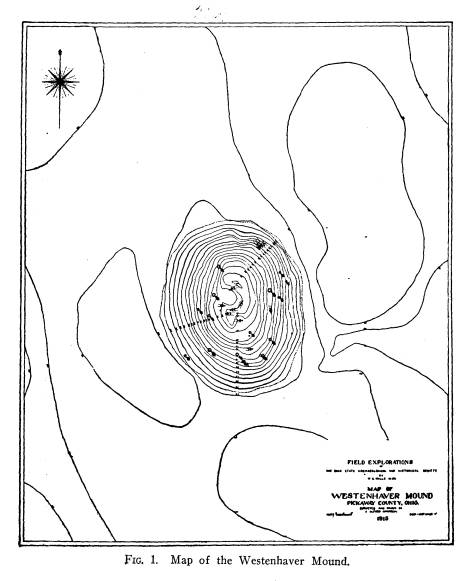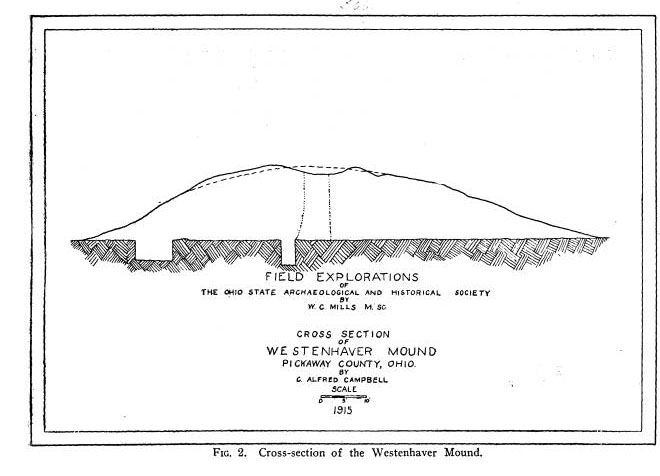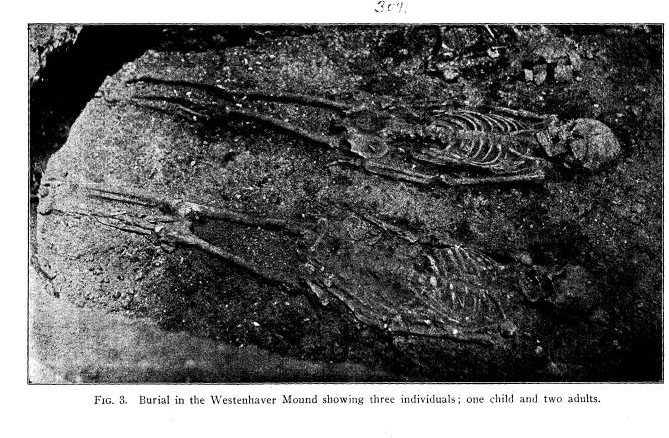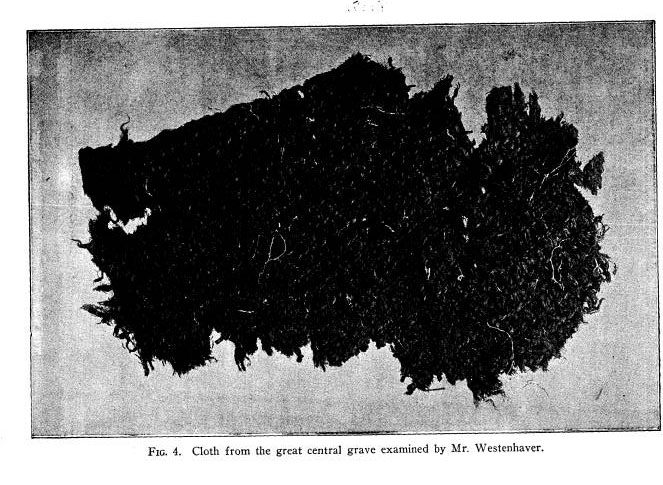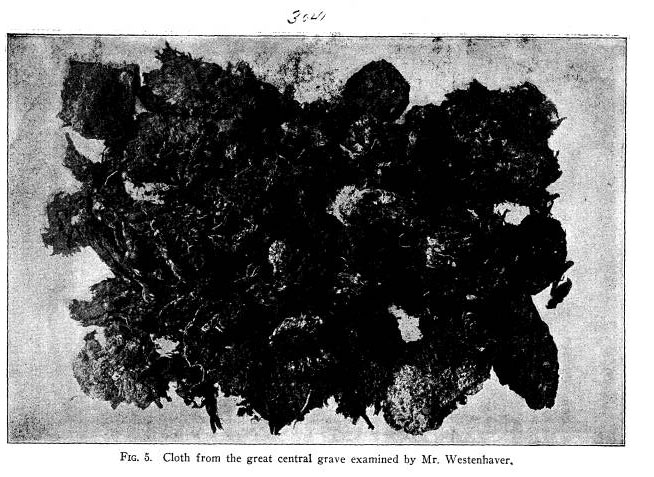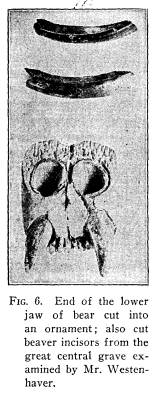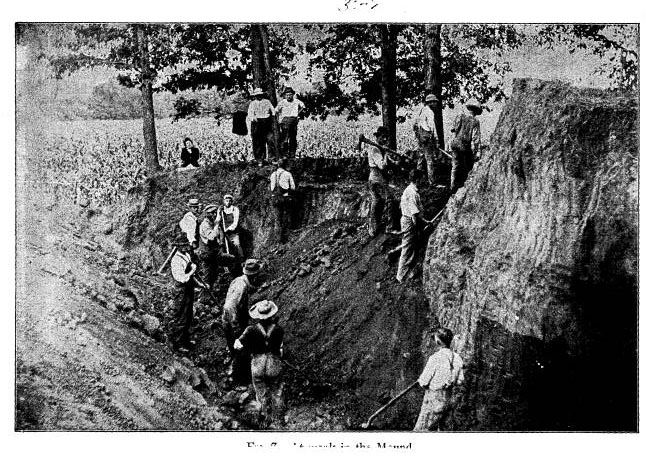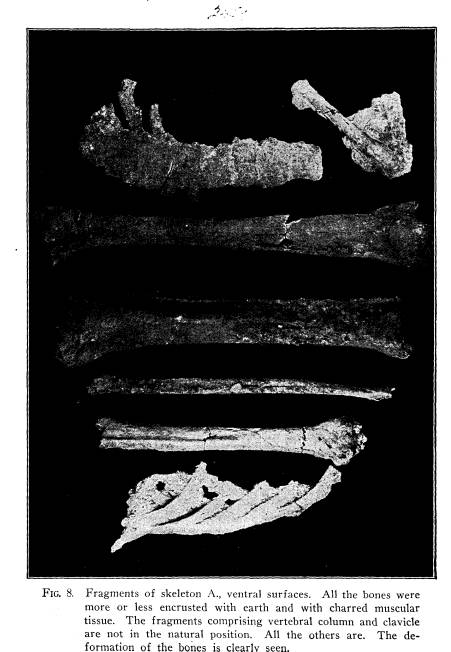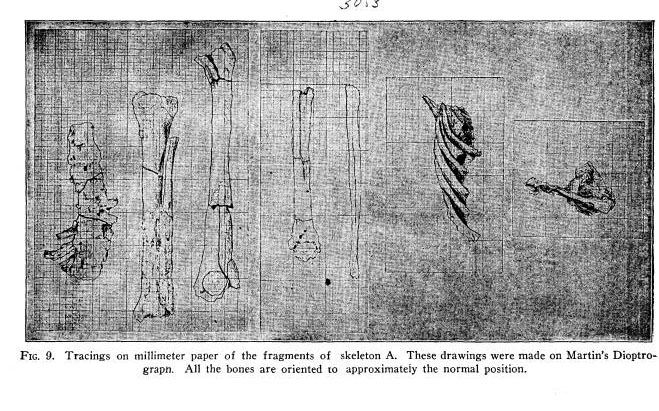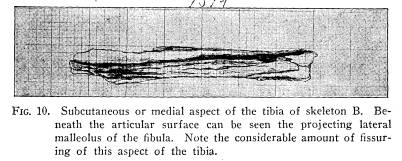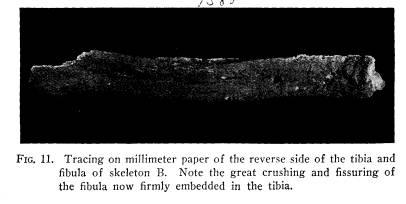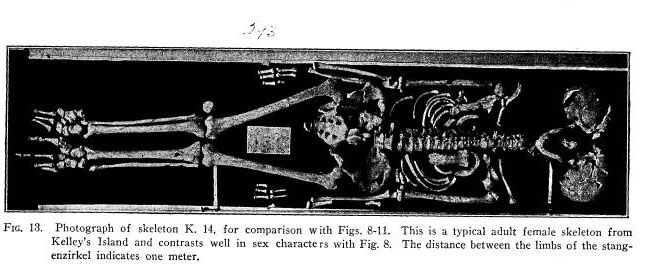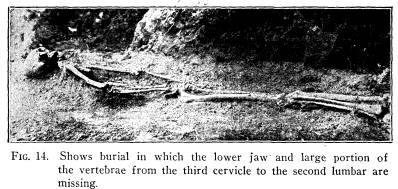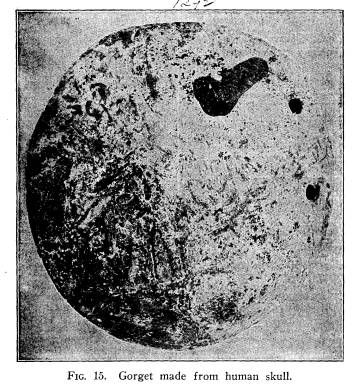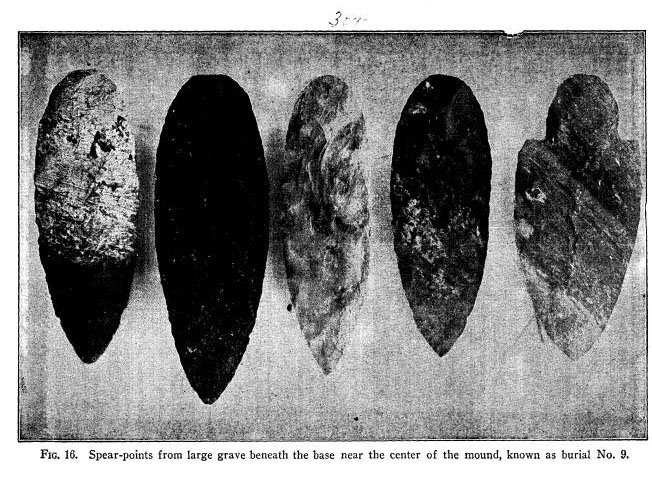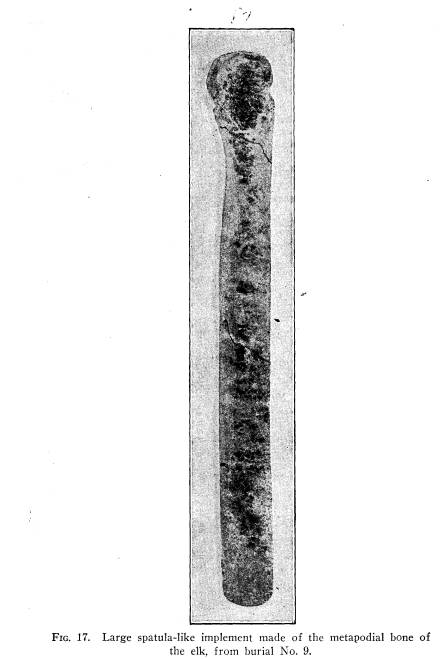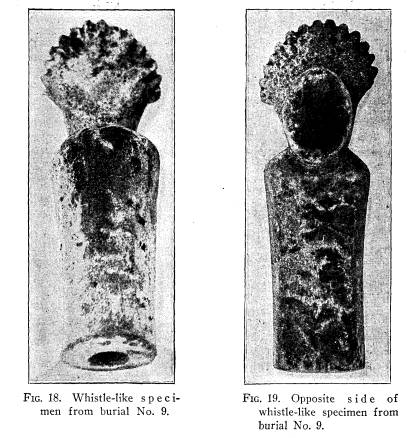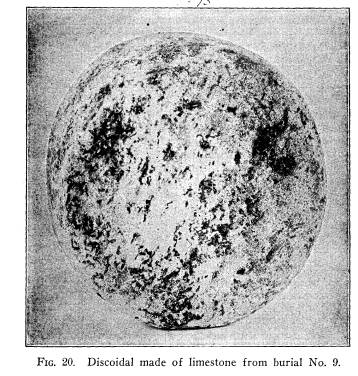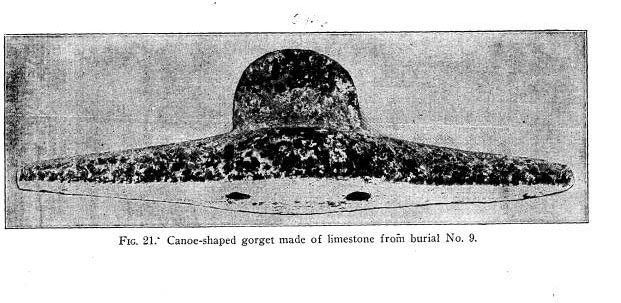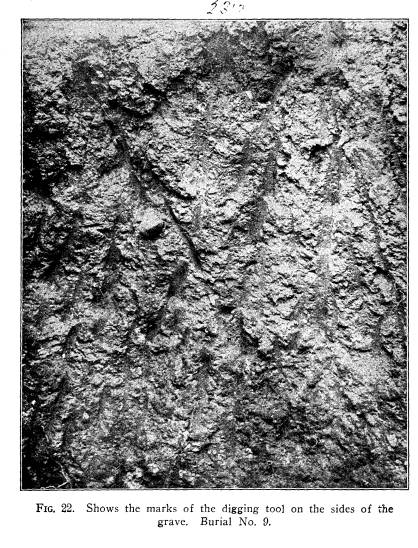Ohio History Journal
- 1
- 2
- 3
- 4
- 5
- 6
- 7
- 8
- 9
- 10
- 11
- 12
- 13
- 14
- 15
- 16
- 17
- 18
- 19
- 20
- 21
- 22
- 23
- 24
- 25
- 26
- 27
- 28
- 29
- 30
- 31
- 32
- 33
- 34
- 35
- 36
- 37
- 38
- 39
- 40
EXPLORATIONS OF
THE WESTENHAVER MOUND.
BY WILLIAM C. MILLS.
The Westenhaver Mound is located in
Wayne township,
Pickaway county, Ohio, on the west bank
of the Scioto river.
The land on which the mound is situated
is owned by Mr. and
Mrs. George E. Roth, and lies about six
miles southwest of Cir-
cleville and three miles north of the
village of Yellow Bud.
The site of the earthwork is a level
plateau, comprising the
first bottom of the Scioto river, which
at this point is elevated
almost fifty feet above low-water mark
of that stream. The
river, which is distant only a few
hundred feet from the site of
the mound, encroaches so closely upon
the terrace forming the
first level above its bed, that barely
enough room existed for
the construction of the Ohio canal, the
natural waterway being
separated from the artificial one only
by a narrow towpath.
The land comprising this first bottom is
typical of this rich
section of the Scioto valley, being
principally a clayey loam, from
two feet to ten feet deep, overlying
deposits of gravel.
HISTORICAL DATA CONCERNING THE MOUND.
The Westenhaver Mound takes its name
from a former
owner of the farm, who more than a
quarter of a century ago
made a partial examination of it. At
that time, the idea pre-
vailed generally that burials within
mounds were to be found at
the center on the base line.
Consequently workmen sunk a shaft
with the idea of exposing that portion
of the base, and in this
instance their expectations were
justified, as perhaps the most
interesting burial in the structure was
uncovered.
This burial, the principal one of the
mound, occupied a
specially constructed grave, and was
remarkable for the great
amount of woven fabric accompanying it.
Fortunately, parts of
the skeleton remained in the grave,
which we were able to ex-
amine with some satisfaction. The
interment is more fully de-
scribed under the head of burials
contained in the mound.
(227)
228 Ohio Arch. and Hist. Society Publications.
The results of Mr. Westenhaver's
examination were pub-
lished in a local newspaper, but in the
absence of the published
account or of any person having exact
knowledge in the matter,
it is not known definitely what, besides
the cloth, was removed
from the grave. It is believed however,
that ornaments or im-
plements must have accompanied so
important a burial, and this
belief is strengthened by the finding of
a copper bracelet in the
earth near the top of the mound which
evidently had been thrown
out of the shaft at the time of Mr.
Westenhaver's examination.
This bracelet is typical of the culture,
round in cross-section, and
about two and three-fourths inches
across. Although copper is
to be expected in mounds of this
culture, the bracelet is the only
specimen of the metal found.
The fabric found with this burial
perhaps comprised the
largest and best preserved exhibit of
cloth ever taken from an
Ohio mound. The entire lot later was
secured from Mr. Westen-
haver by a collector residing in Dayton,
and upon his death was
sold, partly to Dayton collectors and
partly at auction by a Bos-
ton firm. Through the generosity of Mr.
McMurray, of Day-
ton, a fine specimen of the cloth is now
in the Museum of the
Ohio State Archaeological and Historical
Society.
THE MOUND, EXTERNALLY.
At the time of the present examination
of the Westenhaver
Mound, the site was a cultivated field,
and although farmed for
many years, the mound itself had never
been plowed nor cleared
of trees, owing to its abrupt contour.
On the west and south
sides, it was covered with trees and
grass, while on the east and
north, a tangle of trees, vines and
undergrowth completely
covered the surface. The trees covering
the structure were
seventeen in number, consisting of white
oak, red oak, black wal-
nut, and hickory, and ranged from a few
inches to one of two
feet in diameter. Their removal
necessitated considerable labor,
and the roots, penetrating every portion
of the mound, were a
source of hindrance throughout its
examination.
Explorations of the Westenhaver
Mound. 229
SURVEY OF THE MOUND.
On June 18, 1915, preliminary to the
examination of the
earthwork, Mr. C. A. Campbell began a
survey for a topographi-
cal map, shown as Fig. 1. The maximum
height of the mound,
as shown by this survey, is 16 feet,
while its base, which is
elliptical in outline, is 110 feet along
its north and south axis, 90
feet along the east and west axis, and
its perimeter approximately
320 feet. The solid content of the
structure was found to be
about 1900 cubic yards.
After completing the field work
necessary for compiling the
topographic map, Mr. Campbell
established secondary traverse
points on and adjacent to the mound, and
from these by the aid
of the instrument located the burials as
they were uncovered.
The map, prepared from his notes, is
shown as Fig. 2, and illus-
trates a cross-section of the mound.
THE WORK OF EXCAVATION.
The actual examination of the mound was
begun June 21,
1915 and required the greater part of
three weeks, and the labor
of ten men to complete it. Excavation
was begun at the south-
east side at the base line, a cut being
extended fifty feet to the
south and then an equal distance to the
north.
It was found that the mound was
constructed mainly from
the surface soil immediately surrounding
the site, as shown by
the topographical map. Within the body
of the mound were oc-
casional pockets of gravel, while near
the base piles of clay and
gravel indicated a sub-base burial.
The examination of the mound was greatly
retarded by
frequent rains which filled the cuts,
necessitating much time and
labor to place them in condition to
proceed with the work.
Again, the mound from top to base was
literally honeycombed
with burrows of the groundhog. These
burrows carried surface
water into the interior of the mound,
resulting in damage and
deterioration to burials, and as the
season was extremely rainy,
many places within the structure were in
such condition that
critical examination was very difficult.
|
230 Ohio Arch. and Hist. Society Publications. |
|
|
232 Ohio Arch. and Hist. Society Publications.
FEATURES OF INTEREST.
A number of interesting features
characterized the examina-
tion of the Westenhaver Mound, several
of them never before
having been noted in the Ohio mounds.
Chief of these features
were the pathological flattening and
mineralizing, accompanied
by partial mummification of the bones
and flesh of two burials;
the very bold and distinct marks of the
digging stick in the
tough clay walls of the principal
sub-base grave; and the use of
logs and brush to supplement earth, in
building up the body of
the mound.
This latter condition was observed
principally at the south
side of the mound, where the imprints of
trees varying in dia-
meter from five inches to two feet
showed that the site at that
point had not even been cleared in
preparation for the erection
of the mound. Other mounds examined have
shown the use of
logs and brush in leveling the site and
in filling in low places in
preparation thereof, later being covered
with earth to produce
a uniform base, but in this instance,
the south side of the site was
naturally highest, and the logs had been
used in lieu of earth in
the construction of the work.
A total of fifteen burials were located
in the mound. Three
of these were on the base line, four
below the base, and eight
were scattered promiscuously through the
body of the mound.
The original burial probably was one
found near the center of
the mound, in a dug grave four feet
below the base line. Prac-
tically all the artifacts found
accompanied this burial. The only
burial placed directly on the base line
having a well prepared
grave, was that uncovered by Mr.
Westenhaver near the center
of the structure. The burials scattered
throughout the mound
showed many interesting examples of
reburial, individual bones
often being missing, and those present
occupying positions for-
eign to the skeleton as a whole. Aside
from these secondary
burials, the usual position of the
skeletons was at full length,
upon the back.
DESCRIPTION OF THE BURIALS.
The first burials found were near the
north side of the
mound, and are shown in Fig. 3. In an
unusually large grave,
234
Ohio Arch. and Hist. Society
Publications.
seven feet six inches long, five feet
wide, and extending four
feet below the base line, had been
buried three bodies, two adult
males, and a child, from seven to ten
years old.
The adults had been placed in the grave
at full length,
arms extended close to the body, while
the child lay in a flexed
position, on the right side. The heads
of all three were toward
the east. No implements or ornaments
were with the bodies,
but within the grave above them were
found four well-wrought
flint arrowpoints, which apparently,
together with their shafts,
had been placed there intentionally at
the time of burial.
Burial No. 4, the remains of an
adolescent, was found on
the east side of the mound, about ten
feet below the top. The
skeleton had been disarranged by
groundhogs, parts of it being
found some distance away within their
burrows. The skull
however, was fairly preserved, and was
removed intact.
Burial No. 5, corresponds to the one
exhumed by Mr.
Westenhaver previously referred to. This
burial was the most
interesting of the entire mound, owing
to the great amount of
woven fabric accompanying it, and to the
fact that it occupied
a well prepared sepulchre made of logs.
Sufficient of the burial
remained undisturbed to afford a fairly
definite idea of its
original condition. The north end of the
grave had not been
destroyed, and the bones of the feet and
a quantity of the
charred cloth accompanying the body were
undisturbed. The
cloth is shown in Figs. 4 and 5.
Also a number of ornaments made of bone
and teeth were
left in the grave. The most interesting
of these was an orna-
ment made of the end of the lower jaw of
the black bear which
includes the incisors and the canines of
a young animal as shown
by the hollow canines. Also a number of
cut incisors of the
beaver which had the appearance of
forming a part of a necklace.
The specimens are shown in Fig. 6.
It developed in examination that Mr.
Westenhaver's shaft
had pierced the grave at the south end,
or at the head, and
that the shaft had been enlarged at the
bottom to permit of
the removal of the skeleton and its
accompanying objects. The
deduction therefore is that the burial
was similar to many others
characteristic of the early Hopewell
culture; that it had been
|
Explorations of the Westenhaver Mound. 237 placed fully extended in the grave, with the head to the south; that the body had been wrapped in cloth, and that a covering of grass and twigs had then been placed upon the body and this inflammable material then burned. This fire ceremony, frequently observed, accounts for the charring and consequent preserving of the fabric placed with bodies in the Hopewell culture. |
|
|
|
While positive and conclusive evi- dence of the performance of such a ceremony in this instance may be lack- ing, the scant remains within the grave make it very probable that the same conditions found at both the Harness Mound* and the Seip Mound* prevailed here also. Remains of the charred cloth, twigs and branches showed that a fire had been kindled, and covered with earth while still burning. No evidence of the charring of the logs comprising the sepulchre was to be seen. Taken all together, the evidence points to the first ceremony of kindling the sacred fire over the dead, as the initial step in constructing the mound, or in its con- secration, and then of covering this fire while burning, with earth. Burial No. 6, owing to the flattened condition of the bones and the par- tially mumified flesh attached to them, is of particular interest. This burial was placed just east of the center |
|
of the mound, and about nine feet below its top. The head *The Harness Mound is located eight miles south of Chillicothe, along the Scioto river. See "Certain Mound and Village Sites in Ohio," vol. 1, pt. 4. *The Seip Mound is located three miles east of Bainbridge on Paint creek. See, "Certain Mounds and Village Sites in Ohio," vol. 2, pt. 1. |
238 Ohio Arch. and Hist.
Society Publications.
lay to the south about six inches higher
than the remainder of
the skeleton. With the exception of the
skull and feet, all bones
of the body were peculiarly and
strikingly flattened, with in-
durated muscular tissue attached to
them, giving a general im-
pression of having been subjected to
great pressure. The bones
of the lower leg were stained with a
small amount of red ochre,
the only burial showing this condition.
Indications of the ceremony of the
sacred fire were unmis-
takable in this instance, and the idea
presents itself that the
flattening of the bones may be the
result of this proceeding, in
part at least. It might be possible that
at a certain stage of
the ceremony, when heat had placed the
skeletal parts in a
favorable condition, that the heaping
over them of the heavy
earth covering would inaugurate such a
change or flattening,
the process being furthered by the
weight of the incumbent
earth and subsequent trampling above the
burial. Again, the
idea of a primary scaffold burial,
presents itself as possibly
explaining the preservation of the
muscular tissue. Provided
the season of the year and the
atmospheric conditions were
favorable, the muscular substance would
become dry and hard,
and thus be preserved; or the submitting
of the body to the
action of smoke while on the scaffold,
as an intentional means
of preserving the flesh, may not be
unworthy of consideration.
In either event, of course, secondary
disposition of the body in
the mound followed.
However, feeling the desirability of
expert opinion in the
matter, portions of the skeleton,
together with parts of that
from burial No. 7, found nearby and
exhibiting a similar condi-
tion, were submitted for expert
anatomical examination and
report to Dr. T. Wingate Todd, of the
Western Reserve Uni-
versity Medical School, Cleveland. The
rarity of such condi-
tions in skeletal remains in the Ohio
mounds and the evident
interest attaching thereto, seem to
warrant full consideration
of the subject. Dr. Todd's exhaustive
report follows:
"The bones sent for examination
prove to belong to two
different skeletons, both of which have
suffered considerable
post-mortem deformation and are almost
entirely mineralized.
Of skeleton A there are a portion of the
dorsal vertebral column,
240 Ohio Arch. and Hist.
Society Publications.
the right clavicle and humerus, the
upper seven right ribs, the
right fibula, the left femur, patella,
tibia and fibula. Of skeleton
B there are only the right tibia and
fibula. The tibia and fibula
of skeleton A are still encrusted with a
considerable amount of
earth and crystalline material, which is
present on the other
limb bones in much less amount and
indeed is absent from the
bones of skeleton B. Portions of the
scalene muscles remain
attached to the first rib and remnants
of the intercostals can be
seen between the others. Vegetable
fibres are still to be found
embedded in the bones or incrustation
together with ochre and
wood ashes. All of these will be
discussed in the appropriate
place.
"In the consideration of such bones
many questions pre-
sent themselves. Were the bones crushed
through external in-
fluence alone, or did some pathological
condition of the skeletons
themselves form the main or even an
accessory factor in the
deformation? May they be part of the
skeletons of pregnant
women which have undergone pathological
softening during life?
Are they merely the bones of senile or
stout individuals which
would resist less than usual the
pressure of the soil above them?
In what way has it come about that
actual muscle has been
preserved? Have there been attempts at
post-mortem preserva-
tion? Of what nature are the vegetable
fibres and how did
thy come to be there? Are the ochreous
and other stains on
the bones evidence of mutilation before
burial? Do the ashes
signify cremation?
"Let us consider first the bones
themselves and their de-
formation. Fig. 8 is a photograph of the
bones of skeleton A.
All except the vertebral column and the
fragment showing
clavicle and first rib are placed
naturally with their distal ex-
tremities below. The portion of
vertebral column however, is
inverted, the narrower end being the
uppermost, and the clavicle
is so placed that its lateral extremity
points upward and toward
the right.
"The fragment of vertebral column
consists of eight
vertebrae from the dorsal series
together with adjacent parts
of several ribs. On careful examination
of the reverse aspect
portions of the spines can be seen
embedded among charred
|
|
|
Vol. XXVI -16. (241) |
242 Ohio Arch. and Hist.
Society Publications.
remnants of muscular tissue. The
vertebrae are so crushed that
on an average the ventral and dorsal
surfaces are separated by
only 6 mm. The dorsal aspect of the
fragment is slightly con-
cave and exhibits impressions indicating
that the column has
been flattened out upon some resistant
material of irregular sur-
face part of the superficial layer of
which now adheres to the
bones. There is no spondylitis. The
bones can be identified with
fair accuracy for the lowest has rib
lying in contact with it, and
in spite of the compression it can
easily be recognized that the
uppermost vertebral body is the
smallest. It is unlikely then
that this is higher than the fourth
dorsal. Estimating on this
basis, there are the 4th, to the 11th,
dorsal vertebrae inclusive
together with the heads of the 7th, 8th,
9th and 10th ribs on
the left side and the 9th,
10th and 11th ribs on the right. If the
higher vertebra be estimated as the
fifth, we should have to
allow that the lowest right rib is the
twelfth and careful ex-
amination of the costal remnants forces
me to reject this sugges-
tion. All the bodies are cemented
together into one piece and
it is not always easy to identify the
area corresponding to the
intervertebral disc. The various
dimensions are read at a glance
from Fig. 9, from which also it is seen
that the heads of the left
ribs are embedded on the ventral surface
of the vertebra while
those of the right side are hidden
behind the flattened out
column. Thus the area of at least the
lower vertebrae shown
in the photograph corresponds rather to
the left ventral aspect
of the bones. In other words the
compressing force has caught
the spinal column obliquely and since
the vertebrae would
naturally fall on one or other side as
the body settled down this
oblique compression is easily
understood. It is also evident that
the settling of the body and the turning
to the right of the
vertebral column occurred while the
costo-vertebral ligaments
were still more or less intact.
"The fragment of right thorax like
the last mentioned shows
evidence upon its reverse face of an ash
laden surface. In
spite of the compression, enough of the
curvature of the ribs
has remained to make it certain that
they are upper and not
lower members of the series. The
highest, moreover, is broader
than the others and by comparison with
its neighbor and with
244 Ohio Arch. and Hist.
Society Publications.
the first rib which is definitely known,
it is at once identified
as the second. This fragment then which
is like the rest appar-
ently mineralized throughout* consists
of the 2d, to the 7th
ribs inclusive of the right side. The
sketch of Fig. 9 shows
perhaps more clearly than the
photograph, the parts of the ribs
preserved and their characters.
"The intercostal muscles are
wonderfully distinct. Their
fibres can be seen clearly under the
microscope and display the
'resinous' appearance characteristic of
muscles so preserved.
The portion of the axillary border of
the scapula united in
this fragment needs no comment.
At once the question presents itself:
What is the nature of
the cementing substance and under what
influence have portions
of muscular tissue been preserved? But
it is simpler to consider
this matter after the actual physical
character of the bones has
been dealt with.
"The fragment including the
calvicle and first rib of the
right side shows also certain
prominences which from their shape
and position seem to be the ventral
limbs of the transverse proc-
esses of the 5th and 6th cervical
vertebrae. It is impossible to
confirm this however, for on the reverse
surface a root has
grown and embedded itself in the
material just where one would
expect to find vestiges of the spines.
Like the two last men-
tioned fragments this one presents a
rough and somewhat con-
clave ash-laden dorsal surface. The
clavicle is turned so that
its ventral surface lies uppermost, the
inner forward convexity
arching over the first rib, the outer
backward convexity lying
lateral to the rib (see Fig. 9) and is
so crushed as to approximate
somewhat the ventral and dorsal aspects.
The extremities are
more crushed than the shaft and the
sternal end is broken. The
first rib remains almost intact but some
artificial convexity has
been produced by the bending downward of
the extremities. The
site of the sulous subolaviae is hidden
by the clavicle and most
of the area related to the subclavian
vein is missing.
"Of the right humerus the upper
extremity is missing and
the lower is incomplete. The bone is
compressed so that the
*Apparently only for on floating
fragments on distilled water, oil
globules separated out.
Explorations of the Westenhaver Mound. 245
dorsal and ventral aspects are almost in
contact, but the flattening
is greatest at the extremities. The
trochlear fossa is almost ob-
literated but the fossa oleorani and
bicipital groove are still dis-
tinctly recognizable. Ashes and charred
material encrust the
dorsal aspect of this bone also on which
can be seen many verti-
cal fissures.
"The left femur and patella are in
fair preservation though
much broken up. When the fragments are
placed in position,
the appearance shown in Fig. 9, is
presented. Thus only the
head, neck and condylar surfaces are
missing. The two ends of
the bone have suffered greatly from
crushing which has affected
the femur practically in the sagittal
direction. The compact
tissue of ventral and dorsal aspects
have been forced almost into
contact though the shaft has suffered
less compression than the
two extremities. The normal forward
convexity of the shaft
is obliterated. The lateral and medial
aspects of the upper two-
thirds of the shaft from immediately
beneath the lesser trochanter
have been cracked. The patella is but
slightly crushed. On the
other hand it has made a considerable
depression on the already
much crushed lower extremity of the
femur in which it is firmly
embedded. There is less charred material
on the dorsal aspect
of the femur than on any other of the
bones.
"The left tibia and fibula are
still united by some brick-hard
material round which is a good deal of
earth. The former is
almost complete, the latter bone lacks
its upper and lower ex-
tremities. Both are heavily coated with
a hard soil in which
many quartz crystals can be seen. These
bones, like the rest have
suffered compression but the lower
extremities are only slightly
affected and the middle third of the
fibula seems to have been
protected from compression by the
presence of the tibia of which
the upper extremity and upper third have
suffered severely. The
bones must have rolled outward upon the
settling of the body
because the line of action of the
compressing force passes through
the tibia not in the sagittal direction
but from before, backward
and laterally. Both bones exhibit slight
post-mortem bowing
forward, the maximum convexity occurring
about the junction
of the middle and lower thirds of the
tibia and at a somewhat
246 Ohio Arch. and Hist. Society
Publications.
more distal point on the fibula. Much
splintering and a certain
small amount of charred material are
seen on the dorsal aspect.
"The right fibula is cracked in its
middle two-fourths. It
is flattened only in its upper third
which can be recognized as
such in spite of the absence of both
extremities, by the direction
of the nutrient foramen and in a coronal
direction, so that its
medial and lateral surfaces are forced
into contact (see Fig. 9.)
No distortion has occurred in the length
of the bone. It ex-
hibits very little charred material.
"Since every bone shows compression
in a very definite di-
rection it can be stated with confidence
that the body was lying
in the grave upon its back. This is
confirmed by the fact that
the dorsal aspect alone shows evidence
of the adherence of ashes.
Once this position is admitted the
varying amount of compres-
sion of the several bones is explicable.
In all cases the shaft
naturally shows less distortion than the
extremities, but allowing
for this, the greatest crushing occurred
in the bones of the torso
and arms (which would be placed by the
sides.) The leg bones
suffered less and indeed the lower ends
of tibia and fibula are
scarcely affected. Since the bones of
the vertebral column have
less compact tissue than those of the
limbs it might be supposed
that an equal weight distributed over
the whole body would
cause greater deformation of the
vertebrae. That this was not
the case in the body under consideration
is shown by the fact
that the humerus and clavicle suffered
as greatly or nearly as
greatly as the vertebral column. Earth
must then have been
heaped up more over the trunk than over
the lower extrmities.
It is now clear that the deformation was
largely or entirely due
to external factors.
No pathological condition of any part of
the skeleton need
be invoked as a predisposing cause. Had
there been a local
pathological cause, hemiplegia for
instance, the deformation
would have been distributed otherwise.
It is true that such
distortion might be predisposed to by an
osteomalacic state, by
senility or by excessive bodily
stoutness. But the bones show
no alteration in the relative thickness
of their compact tissue
to the size of the shaft. (Though this
is scarcely measurable
it is easily enough estimated by
experience.) They do not
Explorations of the Westenhaver
Mound. 247
show that reduction of cancellous tissue
found in the light
fragile bones of the senile or the
obese. In fact cancellous and
compact tissue are well marked and the
bones exhibit the texture
of those of an individual in active
middle age. No spondylitis,
no lipping of articular margins are
present to indicate old age
or the wear of life, such as can be
frequently found in Indian
skeletons past the prime.
"If then, we abandon as causes for
the distortion any
pathological condition of the body
itself, we must note what
indications are present of external
factors and to this we shall
return later."
It has been observed that the skeleton
as far as can be
ascertained is that of an individual in
the prime of life. Its
sex is not so easily identified. From
the appearance of muscular
ridges on the long bones, from the
relative size of measured
or estimated articular ends when
compared with the shafts, from
the character of the ribs, experience
would suggest this to be
the skeleton of a woman. But knowing the
great variations
to be found in such bones as are here
preserved, and especially
since the sex of any skeleton may easily
be belied by the appear-
ance of its long bones, one hesitates to
dogmatize. For the
purpose of confirmation or otherwise of
this "biological" read-
ing of the sex, measurements have been
made wherever possible
of the bones of skeleton A and B and are
to be compared with
the corresponding measurements made upon
a typical male and
female Indian taken recently from a
mound in Kelley's Island.
It is to be noted that average
measurements of a number of
individuals have not been taken as
standards. This perhaps
requires a word of explanation. In
individuals of both sexes
there are not only considerable
difference in mere dimensions
of bones and variation in the actual
type and this in the same
race (Cf. Ales Hrdlicka; A study of the
normal tibia. Am.
Anthrop. 1898, vol. XX, p. 307). Therefore the average,
whether it be of dimensions or indices
and ratios, taken over
a large number of bones reduces the
study to a mathematical
statement which may be far from
representing the actual
physical appearance of the bones
investigated. For this reason
typical adult specimens of both sexes
were chosen (Figs. 12 and
248 Ohio Arch. and Hist. Society Publications.
13) and measurements made, which might be taken in
them-
selves and their ratios as approximate sex standards.
In com-
paring with these the measurements on skeleton A, it is
neces-
sary always to have before one the figures of the bones
them-
selves so that when the signs + or - occur, one may estimate
approximately how much should be added or substracted
to give
the real measurement, for through fragmentation and
compres-
sion, the actual measurements are vitiated. At first
sight this
may and probably will seem a very unsatisfactory
method, but
it is the only one possible and if the tables are
carefully com-
pared side by side with the figures on the millimeter
paper, it
will be conceded I think, that one can come pretty
close to the
mathematical truth. In taking measurements direct, from
the
squared paper, it must be remembered that owing to
torsion and
deformation of the bones, the plane of the paper does
not always
correspond with the plane in which the calipers were
held when
the actual measurements were made. In taking all
measure-
ments the directions given in Martin's Lehrbuch der
Anthro-
pologie, Jan., 1914, were carefully followed as a
standard of
uniformity. The number and the title are therefore
sufficient
indication of the method of obtaining each measurement
since
they refer directly to those in Martin's Lehrbuch. In
the case
of the right fibula of skeleton B however, none of
Martin's
measurements were suitable. The two measurements a and
b
at the end of the table were made with the Gleitzirkel
and
these are the only ones taken which are not described
by Martin.
Measurements. No.
3. No 4.
Tibia. R L R L A B
1 General length ..... 387 381+ 361 349+ 350
lb. Length of Tibia.. 376 376+ 355 343 356-
2a. Joint-face
measurement ...
376 377 350
345 341
3 Greatest proximal
epighysis breadth
76 71+ 67.5
67.5 71-
6 Greatest distal
epiphysis breadth
47.5 46+ 44
38+ 47- 40
7 Sagittal diameter of
lower epiphysis..
33+ 36.3 31
32 27+ 31
Explorations of the Westenhaver Mound. 249
Measurements. No.
3. No. 4.
Patella. R L R L A B
1 Greatest height........ 37 .... 37 40.5
2 Greatest breadth ... .... 42.2 .... 36 38.5
Femur.
2 Greatest trochanter
length ..........
445 446 423
422 400?
6 Sagittal diameter at
middle shaft .....
27.5 28.0 28.5
28.5 22+
7 Transverse diameter
at middle shaft..
26.2 23.5 24.0
24.0 27-
8 Circumference of
middle shaft ..... 82.0 80.5 81.5 80 84?
21 Epicondylar breadth 79 82 71 71 70+
29 Angle between neck
and shaft.........
132° 130° 119° 120° 126°?
Humerus.
4a. Greatest epicon-
dylar breadth
... 61 60
53.5 53.0 50+
5 Greatest thickness
at middle ......
24 23.5 21.5
21.5 27-
7a. Circumference at
middle .........
69 66 ?
67 58
11 Breadth of
troch-
lea
............. 24 21
16 16 19-
12 Breadth of Capitu-
lum
............ 19 ?
19.5 19 16+
14 Breadth of fossa
oleorani .........
24 24.5 24.0
24.5 24.5
Clavicle.
1 Greatest
length... 157.5 165.5
141 146 140.7
4 Vertical
thickness
of middle .......
10 9 9.5
8.7 11.5
5 Sagittal
thickness
of middle .......
14 12.5 11.2
9.5 8.5+
6 Circumference of
middle ..........
39 36.5 34
29 33?-
R. Fibula
...........
a. Greatest
sagittal
diameter of lower
epiphysis ........
? 25.5 21.5
21.2 .... 21.0
b. Greatest
coronal
diameter of lower
epiphysis ........
? 18.0 18.0
16.2 .... 14.0
|
250 Ohio Arch. and Hist. Society Publications. "Another small fragment of skeleton A is present which possibly contains the head of one radius but this is by no means certain and hence the piece may be dismissed without further consideration. Making then the reservation which must always be made if the whole skeleton cannot be examined, it can be said that skeleton A is that of an adult woman in the prime of life and that no local or general pathological condition is to be noted on the bones themselves. There is no evidence to point to the cause of death. "The right tibia and fibula, sole remnants of skeleton B in- dicate the body of a woman of middle age. They are badly crushed and fissured (see Figs. 10 and 11). The fibula is flat- |
|
|
|
tened out and firmly compressed against and now united with a similarly compressed tibia the dorsal and lateral surfaces of which have been flattened into one. The dorsal aspect is |
|
|
Explorations of the Westenhaver
Mound. 251
actually concave through pressure upon
underlying material and
the fibula lies in contact with the
lateral area. The medial (sub-
cutaneous) surface has been flattened
out very greatly and con-
siderably fissured. The lower
extremities of the two bones have
suffered much less from compression than
the shafts but show
that the force was applied relative to
the bones in a backward
and outward direction. Actually the
bones have rotated out-
ward as the body collapsed and hence
have been crushed in this
manner.
"The next point to be considered is
the post-mortem treat-
ment of the bodies. I have already
spoken of the evidence of
charred wood encrusting the dorsal
aspect of the bones. It is
evident from the fact that the wood
ashes occur only on this sur-
face that the body was not buried in
soil containing the remains
of fires. It must either have been laid
upon the hearth and
covered over or cremated. There is no
doubt that the latter is
what happened.
"All the fragments, but more
especially those comprising
bones of the torso and arm, show
distinctly vestiges of muscular
tissue and indeed the intercostals and
scalenes can be identified
readily. The muscular tissue is charred
in many places and still
shows the fragmentation of the fibres
produced by the great heat.
Much muscular tissue and what must
indicate the one time in-
tervertebral discs are left, the former
on the dorsal aspect of
the vertebral column and thus the
several vertebrae are firmly
cemented together. The same is true of
the ribs. Minute glob-
ules of oil can still be obtained from
this tissue. Indeed it re-
minded me strongly of the condition seen
in some of the graves
of the pre-dynastic and early dynastic
Egyptians in Nubia. In
these shallow graves in the sand exposed
to the intense heat and
drying influence of the sun, much of the
bodies has often been
preserved without any effort upon man's
part. A somewhat
analogous action has occurred through
fire in the present in-
stance. Muscular tissue from the
thoracic wall from the erector
spinal of the back and from the elbow
remains in considerable
amount and in it the fibre bundles may
still readily be seen. The
other bones show only charred remains of
muscle adherent to
the dorsal aspect. Here and there among
the muscle can be
Explorations of the Westenhaver
Mound. 253
found small masses of carbonized
material presenting the glisten-
ing black surface and finely striated
texture of charred wood
and again fine whitish grey wood ashes,
invariably however on
the under aspect of the body as it must
have lain upon the pyre.
The bones themselves show little
evidence of charring, only the
sternal end of the clavicle displays a
fractured and burned sur-
face. Everywhere the bones are mottled
both externally and
in the cancellous tissue with black
stains. This is not actual
charring. In some instances it may be
altered blood pigment
but in the majority of places it is
undoubtedly due to chemical
action of the soil; so-called humin
stains.
"The tibia and fibula of skeleton B
display these humin
stains also and in addition on the lower
quarter of the fibula
is a distinct area where the bone has
been scorched and blackened
though not burned. The lower part of
this bone also shows
small rust colored patches suggestive
but in the absence of injury
scarcely diagnostic of blood.
"Upon all sides of the lower
extremities of the tibia and
fibula belonging to skeleton A are to be
found minute masses of
red ochre, which can be scraped off at
once with a knife leaving
a clean bone surface. This color is not
to be found upon any
other bones of skeleton A nor is it
present upon the articular
surface of the tibia or fibula. It is
not to be seen on skeleton
B. The idea of actual painting of the bones
may be dismissed
at once. Much clearer evidence for this
than has been produced
so far in literature must be obtained
before one can concede such
a habit of mutilation ever to have
occurred among American
aborigines. In the present instance the
charred muscle upon the
bones indicates that they were not
stripped of flesh. Again ochre
stains occur everywhere round the lower
extremity of the tibia
even on the areas to which the ligaments
of the ankle joints are
attached, but not upon the particular
surface itself. It is not,
however, so clear, whether the skin of
the individual was
painted with ochre before cremation or
whether the color came
from the wrappings. Many vegetable
fibres occur in and among
the bones but all of those which can be
examined are more or
less recent roots. Embedded between the
bones of skeleton B,
however, I found a number of masses of
vegetable fibre which
Explorations of the Westenhaver
Mound. 255
under the microscope proved to be roots
the ends of some of
which were brightly colored with the
same ochre. Apparently
they were accidentally stained by
gathering small masses of
ochre which had been sprinkled over the
body before or after
cremation took place.
We have seen then that the skeletons are
those of adults,
probably women, in the prime of life who
died from some
undiscovered cause and were incompletely
cremated; that they
were laid on their back on the pyre,
that ochre was either
sprinkled upon the bodies or used as a
pigment for the mat-
tings in which they were wrapped and
that after cremation the
bones were not disturbed. There is no
evidence of attempts
of preservation.
"We have still to consider the
causes of the extreme de-
formation. It is certain from the
ascertained relative positions
of the bones that they were not
disturbed after the burning.
Soil was thrown upon them and settled
down among them and
that this was done very soon is shown by
the lack of ash or
charred wood among the soil encrusting
the ventral aspects of
the bones. The soil however is not baked
in any way. The
bones were not entirely mineralized by
the cremation and lay
partially embedded in a mass of charred
wood and wood ashes,
the alkaline reaction of which with the
dampness of the soil
would react upon the bones somewhat as
it does in artificial
maceration. It would make them softer
than usual and more
respondent to external pressure. The
amount of this natural
lye would obviously be greater under the
body than under the
legs and thus the bones of trunk and arm
would be the more
affected. In addition it would be
natural to heap more soil over
the center of the body and thus the
pressure exercised by weight
of earth would be greatest here. But the
weight of soil may
not have been and probably was not the
greatest factor in bring-
ing about the deformation of the bones.
I do not yet know
the precise position of the skeletons in
the mound, but that is
not, to my mind, very important.
"We know that mounds were built
gradually, a bit at a
time as necessary. It is likely then
that the chief factor in
256 Ohio Arch. and Hist.
Society Publications.
distorting the bones was not the amount
of earth heaped upon
them but the steady pressure exerted by
this earth through
constant pattering to and fro of Indian
feet, upon a relatively
small amount of earth, above the burial.
The constant pounding
and continuous pressure upon a skeleton
rendered unnaturally
soft and pliable as these undoubtedly
were, is capable of enor-
mous effect.
"It may be objected that little or
no evidence has been
produced to prove this assertion and
that the result has been
attained largely by a method of
exclusion. This is to a certain
extent true. Sufficient evidence has been obtained to show
that the distortion was not brought
about in any of the other
ways known to be possible. Indeed all
the evidence points to
the external factor. It is, as I have
said, recognized that mounds
were built gradually and at irregular
intervals, and it is con-
ceded that the steady pressure and
effect of well packed soil is
very great. No better example need to be
cited than that found
at Shellal in Nubia by Professor Elliot
Smith and Dr. Wood
Jones. Over this archaic cemetery in
which the bodies were
buried in alluvial mud the main street
of Shellal came to be
situated. Scarcely a skull in this
cemetery retained its proper
shape. (Arch. Survey Nubia, Report for 1907-08. Vol. 11,
1910,
pp. 221-2.) The most likely cause of the hard packing
of a relatively small amount of earth in
an Indian mound is the
constant passing and repassing of the
people over it. In this
way the pressure would start from the
time of the burial and
therefore would act when the bones owing
to decomposition
products and the alkalinity of the wood
ashes were most im-
pressionable."
Burial No. 7, was similar to No. 6 in
that the skeleton was
compressed and the muscular tissue
preserved and attached to
the bones. The burial was placed
directly to the southeast of
the preceding, and about one foot higher
up. This skeleton is
included in Dr. Todd's report, and his
conclusions apply equally
to the two.
Burial No. 8 was found within five feet
of the top of the
mound. It is shown as Fig. 14. This
burial, together with all
those remaining to be described with the
exception of No. 9,
probably represent reburials. In this
instance, the lower jaw,
|
Explorations of the Westenhaver Mound. 257 as well as the vertebrae, from the third cervical to the second lumbar, were missing, and evidently had been removed from their places before deposition in the mound, as the skeleton as uncovered showed no disarrangement. Had the vertebral column been intact, and only the lower jaw missing, there would be ground for believing that the individual had lost the jaw to an enemy, to be converted into a personal ornament or trophy. But under the circumstances it must be inferred that the body had received primary burial, either in a grave or on a scaffold, and that it was later interred in its last resting place. Such use of human bones is by no means uncommon, particularly as re- gards the skull and jaws. A gorget made from a human skull |
|
|
|
was found in the western part of the mound, completely isolated from other objects or burial, where doubtless it had been lost during the construction of the work. This gorget, three and one-fourth inches in diameter, is shown in Fig. 15. Another specimen exactly similar, taken from a mound in Ross county, is in the Museum collection while both the upper and lower human jaws, made into ornaments or trophies, were taken from the Harness mound in Ross county. Burial No. 9 was found four and one-half feet deep in a grave eight feet long, four and one-half feet in width and depth respectively. The skeleton is that of an adult male, about five feet and eleven inches in height. The massiveness of the bones indicate that the individual must have been a man of great Vol. XXVI- 17. |
|
258 Ohio Arch. and Hist. Society Publications. strength. The body was disposed at full length on a bed of prepared bark in the center of the floor of the grave, with the head to the south, and the hands beneath the hips. Near the right hip was found a cache of flint blades, fifteen in number, and with one exception (a stemmed or shouldered specimen) of the lanceolate, unnotched type. The specimens are about of |
|
|
|
one size, averaging four and one-half inches in length, and are made from a mottled black flint, found in the coal measures of southern Ohio. Fig. 16 shows both types. Near the lower right arm was found a spatula-like im- plement, made of a split metapodial bone of the elk, eleven and one-half inches long (Fig. 17); a peculiar whistle-like specimen of buff colored stone (Fig. 18); a chipping tool of bone, and a |
|
|
|
(260) |
|
Explorations of the Westenhaver Mound. 261 discoidal stone (Fig. 20). A unique canoe-shaped gorget of yellowish limestone lay alongside the bones of the lower left arm. This specimen primarily is of the usual type, flat on the base, rounding on top and expanding at the center of each side, but in addition it has an extension from the top center, extend- |
|
|
|
ing from one to the other of the two usual perforations. This extension is less than one-half inch thick and one inch high, and is parallel with the longest axis of the gorget. A groove along its curved top evidently accommodated a cord passing from one perforation to the other. (Fig. 21.) This gorget is |
|
262 Ohio Arch. and Hist. Society Publications. the only one of its kind, so far as known, taken from an Ohio mound. Perhaps the best illustration yet noted of the method of digging employed by the Ohio aborigines was shown in this grave. In the tough clay of its sides and ends, as fresh in ap- pearance as if but recently done, were the clean-cut marks of the digging stick, where it had been driven into the earth with |
|
|
|
a stone hammer or maul, and then used as a lever for dislodging the chunks of clay. These marks, very bold and distinctive, were from one-half inch to one inch in diameter, extending vertically from the surface and showing the form of about one- half the thickness of the tool. They are shown in Fig. 22. An interesting feature of this subterranean grave was that the body was furnished with unusual protection, in that the |
|
264 Ohio Arch. and Hist. Society Publications. |
|
|
Explorations of the Westenhaver
Mound. 265
remains were placed in a sepulcher built
of logs. The logs
covering the top of the grave would
serve to restrain the super-
incumbent earth doubtless for many
years, or at least until the
earth composing the mound above them had
assumed a settled
and compact form. Eventually however,
the decay of the logs
would permit the soil gradually to
crumble into the grave, fill-
ing it with the loose earth, and leaving
above it an arched cavity.
The gradual slipping down of the loose
earth, in this instance,
was noticeable to a height of six or
eight feet above the top
of the grave. This condition is often
noticeable in mounds con-
taining subterranean burials, and is an
infallible clue to their
location. In this particular grave, the
soil filling it was so loose
that it was readily scooped out with a
hand trowel, leaving the
grave as fresh and clean-cut as if newly
dug.
Burial No. 10 was placed five feet above
the base line. It
had been so disarranged by groundhog
burrows that little could
be learned of its original condition,
many of the bones being
missing and scattered.
Burial No. 11 was an adult male, placed
two and one-half
feet above the base of the mound. One
arm and both feet were
missing, indicating a re-burial. No
implements or ornaments
were placed in the grave, the same being
true of all the secondary
burials.
Burial No. 12, was that of an
adult female, but only the
skull and the arm and leg bones were
present.
Burial No. 13, an adult male, was placed
at the extreme
southeast corner of the mound.
Practically all the small bones
were missing, and the-larger bones
present were badly decom-
posed.
Burial No. 14, placed in the southern
section of the mound,
four and one-half feet above the base
line, was very incomplete.
The head, one arm, and parts of both
feet were missing. The
grave had not been disturbed and
doubtless represented a re-
burial.
Burial No. 15, the last one found in the
mound, was located
at the southwest side, four feet above
the base and but 18 inches
below the surface. The skull and a few
long bones only were
found.
266
Ohio Arch. and Hist. Society
Publications.
CONCLUSIONS.
The examination of the Westenhaver mound
shows that it
belongs to the early Hopewell culture,
and in many ways re-
sembles the Adena mound, located near
Chillicothe. These
mounds represent an interesting and
distinct stage in the de-
velopment of the Hopewell culture, to
which they undoubtedly
belong, as evidenced by the possession
and use of copper, the
skillful carving of stone, and other
characteristics of the highest
of the several cultures of Ohio
aborigines. However, the use
of copper, artistic stone carving and
other marks of the typical
Hopewell peoples are not so frequent as
in the mounds represent-
ing the highest development of that
culture, while on the other
hand evidences and influences
attributable to the lower cultures
are more abundant. While the use of the
sacred fire ceremony
appears to have held a prominent place
with these intermediary
peoples, as well as with their more
advanced prototypes, they ap-
pear not to have reached the plane where
cremation of the dead
was practiced.
With evidences of cultural advancement
through any consid-
erable period of time so obviously
lacking, as regards the aborigi-
nal inhabitants of the Ohio valley, it
is perhaps gratifying to note
that here, at least, in tracing the
history of the Hopewell culture,
we have at last something very definite.
The evolution from a
lower to a higher plane is exemplified
in the Adena and Westen-
haver stages, with such mounds as the
Seip and Harness inter-
mediate, and the Hopewell and Tremper
mounds representing the
highest development.
Future explorations doubtless will more
clearly demonstrate
this cultural development and furnish
examples of still other
stages in the process.
EXPLORATIONS OF
THE WESTENHAVER MOUND.
BY WILLIAM C. MILLS.
The Westenhaver Mound is located in
Wayne township,
Pickaway county, Ohio, on the west bank
of the Scioto river.
The land on which the mound is situated
is owned by Mr. and
Mrs. George E. Roth, and lies about six
miles southwest of Cir-
cleville and three miles north of the
village of Yellow Bud.
The site of the earthwork is a level
plateau, comprising the
first bottom of the Scioto river, which
at this point is elevated
almost fifty feet above low-water mark
of that stream. The
river, which is distant only a few
hundred feet from the site of
the mound, encroaches so closely upon
the terrace forming the
first level above its bed, that barely
enough room existed for
the construction of the Ohio canal, the
natural waterway being
separated from the artificial one only
by a narrow towpath.
The land comprising this first bottom is
typical of this rich
section of the Scioto valley, being
principally a clayey loam, from
two feet to ten feet deep, overlying
deposits of gravel.
HISTORICAL DATA CONCERNING THE MOUND.
The Westenhaver Mound takes its name
from a former
owner of the farm, who more than a
quarter of a century ago
made a partial examination of it. At
that time, the idea pre-
vailed generally that burials within
mounds were to be found at
the center on the base line.
Consequently workmen sunk a shaft
with the idea of exposing that portion
of the base, and in this
instance their expectations were
justified, as perhaps the most
interesting burial in the structure was
uncovered.
This burial, the principal one of the
mound, occupied a
specially constructed grave, and was
remarkable for the great
amount of woven fabric accompanying it.
Fortunately, parts of
the skeleton remained in the grave,
which we were able to ex-
amine with some satisfaction. The
interment is more fully de-
scribed under the head of burials
contained in the mound.
(227)
(614) 297-2300
